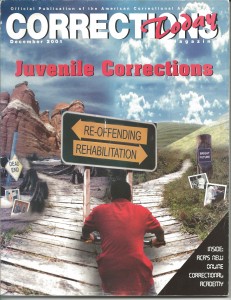 There is little question about it: Most troubled youths have little sense of connection to their communities and do not understand their value as community members or how crime hurts them, as well as their families and friends. On the other hand, youths who feel like part of the community – whose skills and contributions are valued and whose sense of how the community works together – are less likely to become delinquent or to exhibit a host of other behavioral problems.
There is little question about it: Most troubled youths have little sense of connection to their communities and do not understand their value as community members or how crime hurts them, as well as their families and friends. On the other hand, youths who feel like part of the community – whose skills and contributions are valued and whose sense of how the community works together – are less likely to become delinquent or to exhibit a host of other behavioral problems.
The question is, can youths who have entered the juvenile justice system learn that they have skills valued by their communities and come to understand the broad and deep effects crime has on those they care about? The National Crime Prevention Council (NCPC) has discovered substantial evidence that youthful offenders can learn this. It also has found that those in the juvenile justice system can learn in ways that enable them rather than label them, help these offenders see their strengths, and understand the effects and consequences of their actions. Third-party evaluations have concurred.
NCPC has created two successful programs – Youth as Resources (YAR) and Teens, Crime and the Community (TCC) – to work effectively both in the community and in the juvenile justice system. Both YAR and TCC were created to help youths in the community at-large. Young people in a wide variety of neighborhoods and diverse affiliation groups applied for and received Y AR grants and completed projects that met local needs, such as building day care playgrounds, conducting home security surveys for older residents, and designing and creating nature trails for people with disabilities. Projects by TCC students have included beautifying schools and neighborhoods, teaching date rape prevention, running conflict-resolution programs and eliminating graffiti.
Youth as Resources
YAR’s core concept is simple. Since 1987, youths of all kinds – A+ students and those who have dropped out of school, active young leaders and youths who never thought they could lead, youths with perfect records and youths with poor records, and boys and girls from all kinds of groups and affiliations – identify a community problem, design a project to address the issue and apply the program to a community board for funding. Half the community board members are youths and half are adults. Adult sponsors have ranged from churches and school to community centers and youth clubs to juvenile justice facilities.
Projects are limited only by the problem the youths see in their co unities and their creativity in designing solutions. One group determined that a single mother whose children suffered from chronic illnesses urgently needed a new roof on her house. The group worked with a carpenter to build the roof, getting local businesses to donate (or sell at cost) many of the necessary supplies. Other groups have organized escorts to walk younger children to and from school grown vegetables for soup kitchens and homeless shelters, created videos and puppet plays with anti-drug messages, and developed hotlines and counseling groups for teens. The board that examines project applications is grounded in the community. Its job is not just to examine proposals but to raise funds locally to support the projects it approves. The board often is incorporated into a larger community organization, but many boards have incorporated as nonprofit charities. Proposals usually are assessed in interviews with the young applicants after an initial review for basic compliance with application requirements. Local boards often host proposal workshops to help young people think out their plans. Applicants are asked for an explanation of the problems or issues they want to address, a budget, a project schedule and a description of how they will succeed. In the case of the young roofers, their evaluation criterion was clear and direct: “The roof will not leak.” Funding typically ranges from $200 to $5,000 and project terms have been as short as one month and as long as one year.
YAR is experiencing substantial growth. Between 1997 and 1999 alone, keeping its pledge to America’s Promise, YAR involved 100,000 young people in service to community and helped establish 26 new YAR sites around the country.
Teens, Crime and the Community
Created in 1985 by NCPC and Street Law Inc., TCC reaches students in more than 1,000 schools, community settings and juvenile justice facilities around the nation, using both a textbook and a newly developed set of lessons designed for less structured settings, such as youth clubs.
Combining education and action, TCC helps young people understand how crime affects the community and how to prevent it. Rather than labeling youths as “delinquent” or “deviant,” TCC challenges all youths to examine crime’s impacts and to create an action project that deals with a school or neighborhood crime prevention need. Young people have responded by working with older residents, creating peer mediation teams, developing prevention education for peers and younger children, and teaching elementary school children drug prevention and personal safety skills, among other subjects.
TCC is unusual in its community link, which is a core element of the program. Resource people come into the classroom or clubroom to share their knowledge. Victim assistance counselors, mediation experts, police officers, judges, prosecutors, business owners and news reporters are among the many adults who have helped students form positive links with a wide range of community leaders.
TCC has found a home in fifth grade classrooms in Detroit, middle schools in midtown Manhattan, high school civics and ethics classes in Texas, health classes in Arizona and diverse neighborhoods throughout
San Francisco. An entire middle school in New Mexico has infused TCC throughout its curriculum, from English to physical education. TCC has been a success in schools (from fifth to 12th grade), community centers, youth clubs and juvenile justice facilities.
Young people who experience TCC repeatedly report that they not only learn, but apply what they have learned and teach others. “I used to get into trouble – take on little kids like a bully,” says 14-year-old Gabriel of New Mexico. “I tried drugs before my mom found out and once in a while, hung around with gangs. I got in trouble a lot around my neighborhood. It’s different now. I don’t break things and I don’t pick on the little kids anymore. Before I did TCC, I never really thought much about the consequences. TCC made me think differently. I know how to make choices and decisions now. I am not the same person. My older brother would say I’m not really much of a troublemaker anymore.”
“TCC made a great impact on me,” says 13-year-old Cara of Michigan. “If I see someone arguing now, I don’t stand back and watch and say, ‘Ooh’ and wait for something to happen, and if I hear about something, I don’t stir things up with gossip. What I learned, I brought back home and to my friends. A lot of my friends changed because of the program. For instance, one friend decided to try to get into the program because I was doing it. She got in, too. Before, she was always a fighter. Afterward, she calmed down. Now, when she gets into it with somebody, she talks it through or leaves it alone. TCC gave us good information – that helps a lot. It taught us that things don’t have to end in violence.”
Correctional Settings
When brought into correctional settings with properly trained staff, both TCC and YAR have proved effective with young people in correctional care. They fit in with the goals of institutions working toward rehabilitation and toward strengthening youths’ positive community connections toward their eventual, positive return to their communities. In addition, both programs are flexible, adaptable, non-labeling, linked to positive action and well-tested with a wide range of youths. TCC and YAR have succeeded with youths in short- term and long-term facilities, with youths on probation and with youths in aftercare, with residential and with day-report youths.
Josh Perry, a juvenile offender at Plainfield Juvenile Correctional Facility in Plainfield, Ind., believes YAR had a positive effect on his time in custody and his future. “As a delinquent youth at Plainfield Juvenile Correctional Facility, I felt the pressure all around me to fail. I had a strong emotional sense that I would never see freedom … Whispers around the facility reached my ears about a program called Youths as Resources. I was curious as to what this program could do for me.” After contacting a college professor who was his mentor and friend, Perry decided to give the program a chance. The professor told him exactly what it would take to get the most out of YAR. Perry and several others drafted a plan for T.R.U.T.H. (Teaching Reality and Understanding Teen Hurts). Its mission was to educate teens in various communities about topics important to them, ranging from sex, drugs and parenthood, to violence and the life of an incarcerated juvenile.
“Our project had a profound effect on the community,” says Perry. “Little did the community know the juvenile offenders were finally given a sense of accomplishment. We knew this was our project. We knew that as youths, we were allowed to choose what we felt other teens could relate with. Youth as Resources has in every way given me the opportunity to give back to the community.”
More formal assessments, including several third-party evaluations, have documented the positive effects of TCC and YAR. TCC youths studied in a correctional setting demonstrated greater understanding of law, empathy for victims and linkages between law and behavior, as well as how crime affects victims. An evaluation of Y AR youths in Indiana found that youths showed an increased sense of accountability and citizenship, improved life skills, an increased capacity to care, a new ability to partner with adults and hope for the future. Evaluators found similar changes in youths in correctional settings. In both programs, staff reported numerous positive changes in youths’ behavior. TCC youths in correctional settings helped settle arguments peaceably, were better able to describe adverse consequences of their actions and remained focused on and highly engaged in the lessons and project planning.
Carol Duncan, assistant supervisor of education at the Indiana Girls School (IGS), says, “At IGS, if you say
Youth as Resources, everybody knows what you’re talking about. We offered it to all the girls and staff – teachers, counselors, security personnel, and administrators and eventually, everybody at the facility was in some way touched by the program. People out in the community discuss what the girls are doing. We get phone calls and letters all the time thanking us for sending such wonderful volunteers.”
It is possible to bring programs designed for young people in the community into correctional facilities to improve their community connection. It is possible for young people in corrections to benefit from such programs. Clearly, research in youth development suggests that youths need such programs even more than their peers “on the outside” if they are to have a chance to grow up as effective, productive adults.
For more information on publications, training, services and program evaluations, visit http://www.ncpc.org/programs/
*Originally published in the December 2001 issue of Correction Today Magazine, the official publication of the American Correctional Association.



Leave a Reply